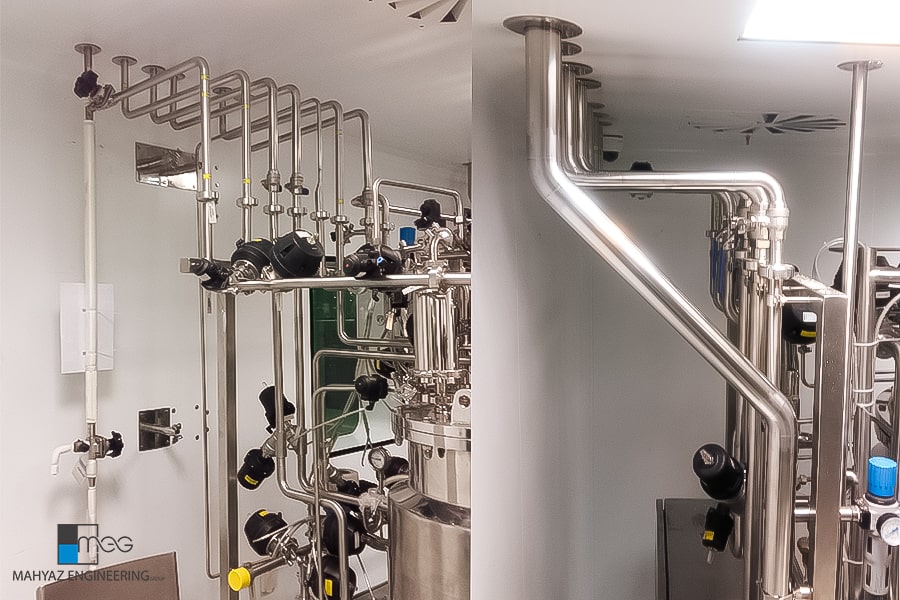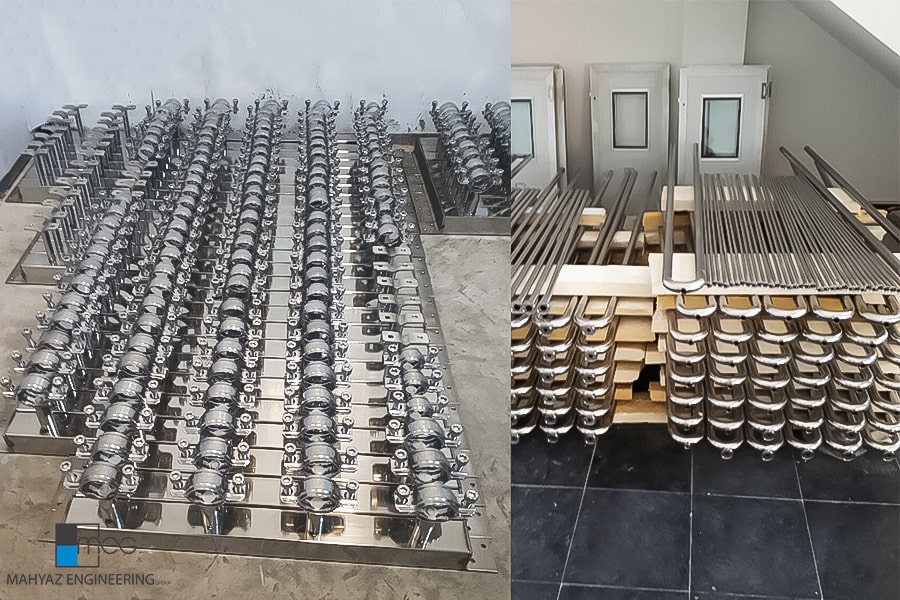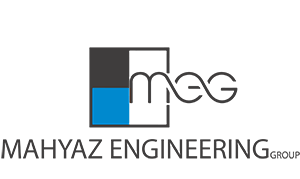In today’s life, steel piping is an integral part of human life. Whether in everyday life for the transfer and use of fluids such as water and gas or in the industry and industrial production. In the industrial sector it can be said that one of the most important parts is that at the beginning of the construction of each pharmaceutical factory along with the development plans, the pipelines’ plans. Stainless Steel Piping of their passage must be specified
In general, using a plumbing network, various fluids can be moved and used as needed. Mahyaz Engineering Company is proud to present one of the first Steel Piping Sets in accordance with the latest global standards by providing documentation to its customers.

Plumbing in industry
Plumbing applications can be classified into several major categories in industries:
1. Transfer Piping:
In this plumbing, it is usually used with large diameters to transfer various fluids. In process plants, such as refineries, fluid transfers between storage units and processes are used.
2. Construction Piping:
In this plumbing, most of which are underground, it is used to distribute urban amenities (water and gas), as well as rainwater harvesting, sewage, and residual utilization.
3. Construction or Commercial Placement:
Plumbing has done in commercial buildings, schools, hospitals. Residential houses, etc., for the distribution of water and gas. Collection of sewage and other purposes.
4. Sea Piping:
Most are used in ports and ships, and most of its parts are made of carbon steel, welded or screwed.
Various design and engineering departments
In general, the design and construction of an (industrial) industrial complex is a complex process that is usually referred to an advisory engineering firm in a country after a project has been defined by an employer from an engineering design and engineering company , and the consulting engineering companies according to the needs the following are usually the following.
- Engineering and design piping section
- Engineering and Design
- Section of Fixed Equipment
- Engineering and Design Department Rotary Equipment
- Department of Engineering and Design of Mechanical Facilities H.V.A.C
- Engineering Structure and Structural Structure Design
- Engineering and Design Department of Electrical Installations
- Engineering Process and Design Process
- Engineering and Design Department of I & C Instrumentation Systems
- Civil Engineering & Civil Engineering & Architecture
- Estimation of Goods and Purchases
- Department of Industrial Engineering and Project Control
Piping Equipment and Materials Required
The term piping is generally related to the flow of fluid through the pipe. Fittings and valves are used. Then the main component is always the pipe, which requires some basic definitions.
Pipes:
Products that come in tube form are commonly referred to as tubes or tubes.
Tubes:
Application of tubes in converters Boilers Instrument parts and machines are characterized by an external diameter and wall thickness of one-thousandth of an inch or (bwg).
Pipe:
Pipes are identified by the nominal size of the pipe and the thickness according to the (Schedule Number) and, of course, have different classifications in different standards, for example, the API designation.
Piping Standards
Standards and codes for various services are provided and distributed by international standard institutions. These standards include how to make tubes ,How to use ,Designing ,Branching Connection and testing of pipelines.
In preparing these standards ,the most important thing to be considered is safety during use and work ,and these standards have been completed ,depending on the circumstances ,from the past.
The various piping associations have introduced standards that include:
- American Socity of Mechanical Engineers ASME
- American Socity for Testing and Material ASTM
- American National Standard Institue ANSI
- American Water Works Association AWWA
- American Petroleum Institue API
- Manufacturers Standardization Society of Valve and Fitting Institue MMS
Standard Code (ASME) is more common. This standard plumbing is divided into a variety of applications.
- Power Piping ASME B31.1
- Fuel Gas Piping B31.2
- Chemical Plant and Petroleum Refinery B31.3
- Bioprocessing Equipment BPE
The cutting-edge collection of molding activities in the pharmaceutical industry is based on the ASME BPE standard.
This topic is discussed for pipes that are mostly used in processes.
Size and length of steel pipes
According to the standard (ANSI B36.10M), the pipe wall thickness is stated to be 8.1 to 80 inches in diameter, and the lengths of pipes used are between 6 and 12 meters. and the lengths of pipes used are between 6 and 12 meters.
The ends of the pipes are made in several ways:
- Flat straight PE
- For welding welded BE
- Threaded ends with a T & C coupling
- The other ones are ordered for specific tasks
The diameter and wall thickness
- The tube size is called NPS.
- Tubes of different sizes are made in a few thicknesses, which are expressed by different institutions in different ways.
- In (ANSI) the number (Sch) is used for this purpose.
- At (ASME) and (ASTM) Standard Indicators (STDs)
- Reinforced (XS)
- Double Reinforced (XXS)
- Standard (API 5L) is expressed in standard lengths and diameters
- In general, for the order of the pipe number (Sch), a suitable standard is specified according to the standard (ANSI B36.10M).
Tube material
Most of the pipes used in the industry are made of steel. Steel pipes are divided into two groups according to the construction method.
1.Sealed drains:
The connection of the bending plates is provided.
2.Seamless hinges:
Extruding is done by the mold.
Tube selection based on pressure conditions. Temperature and corrosion values is performed using two standards (API) and (ASTM).
Specifications of different tubes suitable for process lines ,Welding ,Heating and cooling for conventional and industrial applications using (ASTM A-53) and (ASTM A-106) can be specified.
Conventional tubes used in steam services. Water. Gas and air are introduced in the standard (ASTM A-120).
Pipes used in the oil and gas industry should be made according to the API-5-L standard.
Application of tubes according to their gender
- Steel drums made of cast iron or ductile iron for use in water. Gas and sewage lines.
- Stainless steel pipes (SS) are used where high corrosion and chemical resistance are needed.
- Copper tubes and alloys in instrumentation lines. Processes of food and heat transfer equipment are very common.
- Plastic tubes are used to transport corrosive fluids, such as mineral acids and corrosive gases, and chemical compounds.
- Glass washbasins for some specific uses, such as the transfer of specific chemicals. Laboratory applications and in general, low-pressure locations are used.
Temperature range and pressure range
At high temperatures, stainless steel tubes or other alloys are used.
The carbon steel tubes are less resistant. Electro-draped seamless pipes for temperatures above 750 Fahrenheit and seamless furnace tubes for a temperature of 650 F are not recommended.
The pressure range for all types of steel pipes at various temperatures is expressed in the standard (ANSI B31).
Steel and stainless steel pipe connection methods
- Burning butt
- Socket Weld
- Screw
- Tangled Felt
- Swinging
- Pipelines with NPS2 and larger are not connected to the butt by welding.
- Pipelines with (NPS 1 1/2) and smaller are usually connected by connecting or welding sockets.
- Flanged fittings are used where they need to be reopened.
Fittings
To change the pipe path ,Change the diameter of the pipe ,everal shaking of the tube and…. of the fittings are used. In plumbing systems, according to their type of connection, they have their own equipment and fittings, for example, plumbing systems are divided into three groups of buckling – socket welding and screw couplings based on the type of connection.
Each of these methods has one application for itself ,Connecting method ,Advantages and disadvantages of the type of connection, and in general, it is possible to categorize the fitting in each method of connection to two specific groups.
1. Directions for changing the direction of fluid flow and changing the size in pipe diameter
- Like knees ,Mikes Flanges Back Increasing and increasing… Flanges ,Back ,Increasing and increasing …
2.Attachments to split the main path or block a path
- Like tees ,Faces ,Flanges ,Cops and…
Piping system based on butt welding
Place of use:
- For most applications ,Process piping and service lines For Example Stainless Steel Piping
Connection Benefits:
- The best fitting method for pipes with a large diameter to create a reliable connection.
Disadvantages of connection:
- Some welding portions may enter the fluid path and affect the flow pattern.
Connection method:
- The two ends of the pipe or connector must be bucked and then welded in a straight line with an ace.
Piping system based on socket welding
Place of use:
- For toxic and expensive toxic and non-lethal emission lines for steam lines with a pressure of 300 psi (600 psi)
Connection Benefits:
- Centering and adjusting in smaller pipelines is less than boiling on the butt.
- The boiling parts do not enter the main path of the fluid movement.
- If it runs correctly, it never leaks.
Disadvantages of connection:
- There is a gap between the connections that causes fluid trapping
- According to the standard (ANSI B31.1 1989), no high vibration or seam corrosion should be used.
Connection method:
- The end of the pipe should be flat and then placed inside the fitting and round the fillet weld.
Plumbing system based on screw connection
Place of use:
- For service lines and small plumbing processes
Connection Benefits:
- Can simply made by pipe and fitting on the site.
- The risk of fire is reduced due to the lack of welding in high-risk areas.
Disadvantages of connection:
- According to the standard (ANSI B31.1 1989), if there are excessive corrosion and corrosion, the system should not be used with shock and vibration.
- Possible leakage of connections
- May require weld welding.

Types of pipe threads
According to the standard (ANSI / ASME B1.20.1) ,the teeth of the pipe are directly and gently. Most pipe fittings are manufactured with a toothpick and are used for filling with DOPE or Teflon strips. Fit the right teeth using a washer and a nut.
In standard (ANSI B1.20 .3), dentures are defined by dry rubbing, which is provided without the use of any other means and only with the property of wear on the metal. Letters are used to specify the properties of teeth, such as oblique or smooth teeth. For example, (T) indicates the inclined tooth.
Standard (ANSI B1.20.1) specifies pipe thread specifications.
Standard (ANSI B1.20.3) determines the teeth with dry strap.
The pipe threads are shown below.
(Type of tooth) – (Number of threads per inch) – (NPS or pipe size)
NPT 8- 3 Which represents a pipe with a nominal size of 3 and a number of 8 threads per inch with a type of fasting miles.
Gaskets
They are used for fitting between the two surfaces and preventing leakage, and they are made of pressed metal or filler metal. To select the gaskets, a few points to note:
- Temperature ,Fluid corrosion used
- Need to open the flanges continuously for maintenance
- Environmental conditions of operation
- Fixed price
Temporary caps for pipelines:
1.IN-LINE:
These valves are used to stop the flow in the following situations.
Cleaning the pipes and changing the use of pipes.
These valves are used to stop the flow in the following situations.
2.Ends of pipes and outputs of reservoirs:
Which include
BLIND FLANG
T-BOLT caps
Covers (WELDED-ON)
Quick couplings and couplings
Quick connections:
Two types of interfaces for connection are:
- Lever type with double lever fasteners
- Screw type with nut clamp Which for temporary tanks to the car. Hay trucks are tanks.
Quick couplings
These connections can be temporary or permanent in-line repairs according to the type of service and type of fittings and washers. Build. Installation of process lines and…
Bushi Couplings Compression:
In the field of air. Water. Oils or gas are used and have advantages
1.Installation and rapid isolation
2.Possibility to have some expansion and change of direction in connections
3.No need to pay for tubes
Expansion joints and flexible piping:
Benefits
1.Installation and rapid isolation
2.Possibility to have some expansion and change of direction in connections
And more in airborne PLANTs. Water Lines. Service … and oil lines. And for use in a cast-iron or plastic pipes with grooved heads or fasteners (Victaulic) for fitting to the ends of the pipe by welding or cement.
Bushi Couplings Compression:
In plumbing nets to neutralize vibrations and also to control pipe length variations due to temperature changes, expansion joints can be used, or the following methods can be used with the following methods.
1.Change the path of the line
2.Expansion Joints
3.Reduced displacement by the supports
4.Springs
Flexible Piping:
In some cases, such as filling and emptying tankers, flexible pipelines are used in batch chains or ball couplings.
-
Separators Lace Drip (Driplegs)
Devices for the separation of unwanted substances from the mainstream, which can be metal particles – boiling slabs – oils, or even water, each of which is in a state of materials and fluid type.
-
Separators
These permanent devices are used to separate droplets and particles in gas streams.
-
Filters ( STRAINER )
Solid particles are collected in an approximate size of 0.02-0.5 inches, which is carried out by flow through the filters.
-
Drip ( SCREENS )
Simplified simple metal and wire mesh filters that are commonly used when starting a pump and compressor suction.
-
( DRIPLEGS )
It is often made of pipes and fittings and suitable for condensed liquid collecting.
-
Valves ( VALVES )
Typically, the valves are categorized according to the type of operation, for example, the connecting and connecting valves of the current or regulated valves…
Different parts of a tap include:
Disc & Seat (& SEAT) & (DISC & PORT)
Category (STEM)
Body (BONNET)
Operator (OPERATOR OR HANDWEEL).
Valves can be divided into several categories according to their type of operation.
1. Circuit breaker/plug connector
2.Flow adjustment taps
3.The flow for the flow back
4.Flow control valves
Taps suitable for disconnect / connect or setup service:
Industrial piping is usually used to disconnect and connect the flow from the gate valves (these valves are not suitable for regulating the flow because the disk vibration in the case of a closed valve causes the surface and disk space to be corroded).
For some other fluids, spherical valves are used to disconnect current (in general, spherical valves are used to regulate flow).
The valves are divided into different groups based on their type of function and the structure of their disk, and each one depending on the type of fluid Small tubes. Tensions in the handle and body can be used. For example, a solid wedge gate valve for rotary ball valve is used to control flow.
Control valves and flow control:
These lanterns automatically adjust the pressure or flow rate and are also available for each compression class and are usually smaller than the size to prevent choking and trapping and quick damage to the nest, and pressure regulators are usually of the type Spherical.
All items used in the Stainless Steel Piping commissioning and services are provided by the Mahyaz Engineering Company, one of the most trusted Asian manufacturers and service providers of Stainless Steel Piping and PW generators.
Flow return valves:
But there are also valves that are designed to only pass the fluid in a specific direction and prevent the flow from being reversed. For example, the Piston Check Val is suitable where there is a constant flow change and these valves are based on the mechanism of prevention Flow returns or their application to different fluids (gas, heavy liquids, mixtures …) are divided into different types.

